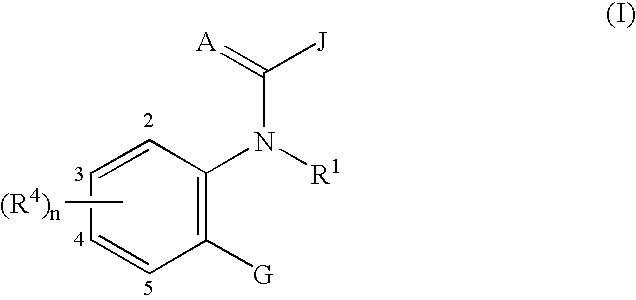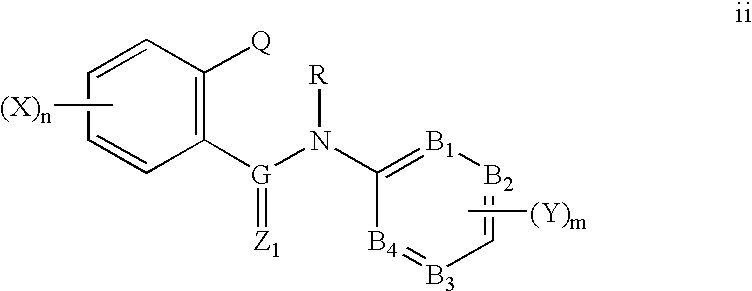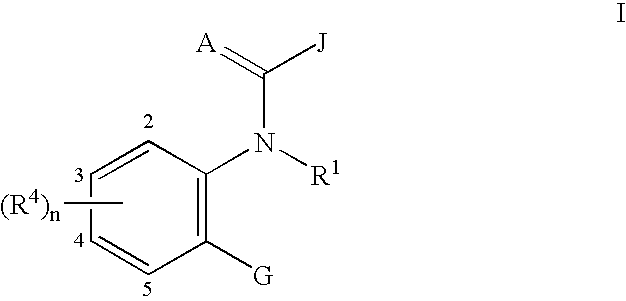Ortho-heterocyclic substituted aryl amides for controlling invertebrate pests
a technology of aryl amide and heterocyclic compound, which is applied in the field of ortho-heterocyclic substituted aryl amide for controlling invertebrate pests, can solve the problems of significant productivity reduction and increased costs for consumers
- Summary
- Abstract
- Description
- Claims
- Application Information
AI Technical Summary
Problems solved by technology
Method used
Image
Examples
example 1
Preparation of N-[4-Bromo-2-(4,5-dihydro-1H-imidazol-2-yl)-6-methylphenyl]-1-(3-chloro-2-pyridinyl)-3-(trifluoromethyl)-1H-pyrazole-5-carboxamide
Step A: Preparation of 4,5-Dihydro-2-(3-methyl-2-nitrophenyl)-1H-imidazole
[0245]A solution of methyl 3-methyl-2-nitrobenzoate 3.13 g (16.1 mmol) in ethylenediamine (15 mL) was heated at reflux for 1.5 hours, at which point the solvent was removed at 130° C. under reduced pressure. The residue was then heated at 190° C. for 1.25 hours before being cooled on ice and purified by flash column chromatography (silica gel, 1% to 10% methanol in dichloromethane) to give the title compound of Step A (0.35 g) as a brown oil.
[0246]1H NMR (CDCl3) δ 7.52 (m,1H), 7.39 (t,1H), 7.35 (m,1H), 3.74 (s,4H), 2.33 (s,3H).
Step B: Preparation of 2-(4,5-Dihydro-1H-imidazol-2-yl)-6-methylbenzylamine
[0247]To a solution of the title compound of Step A (0.5 g, 2.44 mmol) in ethanol (50 mL) was added palladium hydroxide (50 mg, 20 wt % on carbon). The flask was twice ev...
example 2
Preparation of 1-(3-Chloro-2-pyridinyl)-N-[2-1H-imidazol-2-yl)-6-methylphenyl]-3-(trifluoromethyl)-1H-pyrazole-5-carboxamide
Step A: Preparation of 2-(3-Methyl-2-nitrophenyl)-1H-imidazole
[0253]To a solution of the title compound of Example 1, Step A (0.35 g, 1.71 mmol) in dimethylformamide (20 mL) was added activated manganese dioxide (4.46 g, 51.3 mmol) and the mixture was heated at 120° C. for 2 hours. After cooling, the mixture was diluted with ethyl acetate, filtered through a pad of Celite® and washed three times with water and once with a saturated solution of sodium chloride. The organic phase was dried (magnesium sulfate), concentrated and purified by flash column chromatography (silica gel, 60% then 80% ethyl ether in hexanes then ethyl ether) to give the title compound of Step A (0.1 g) as a white solid.
[0254]1H NMR (CDCl3) δ 7.76 (d,1H), 7.46 (t,1H), 7.33 (d,1H), 7.3-7.1 (2×bs,2H), 2.37 (s,3H).
Step B: Preparation of 2-(1H-Imidazol-2-yl)-6-methylbenzenamine
[0255]To a soluti...
example 3
Step A: Preparation of N-[2-(4-Bromo-1H-imidazol-2-yl)-6-methylphenyl]-1-(3-chloro-2-pyridinyl)-3-(trifluoromethyl)-1H-pyrazole-5-carboxamide
[0258]To a solution of the title compound of Example 2 (0.04 g, 0.09 mmol) in dichloromethane (3 mL) was added N-bromosuccinimide (16 mg, 0.09 mmol) and the mixture was stirred at ambient temperature for 1 hour. Purification by flash column chromatography (silica gel, 40% then 60% then 80% ethyl ether in hexanes) gave the title compound of Example 3, a compound of the invention, as a white solid (52 mg).
[0259]1H NMR (CDCl3) δ 11.2 (s,1H), 10.9 (bs,1H), 8.5 (dd,1H), 8.2 (bs,1H), 8.0-7.9 (dd,1H), 7.53 (s,1H), 7.5 (dd,1H), 7.01 (bd,1H), 6.70 (t,1H), 6.63 (bd,1H), 2.30 (s,3H).
PUM
 Login to View More
Login to View More Abstract
Description
Claims
Application Information
 Login to View More
Login to View More - R&D
- Intellectual Property
- Life Sciences
- Materials
- Tech Scout
- Unparalleled Data Quality
- Higher Quality Content
- 60% Fewer Hallucinations
Browse by: Latest US Patents, China's latest patents, Technical Efficacy Thesaurus, Application Domain, Technology Topic, Popular Technical Reports.
© 2025 PatSnap. All rights reserved.Legal|Privacy policy|Modern Slavery Act Transparency Statement|Sitemap|About US| Contact US: help@patsnap.com



